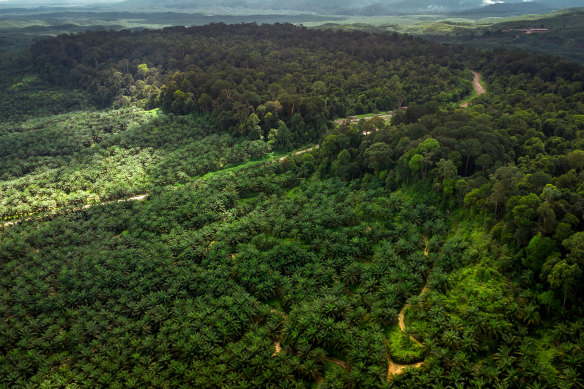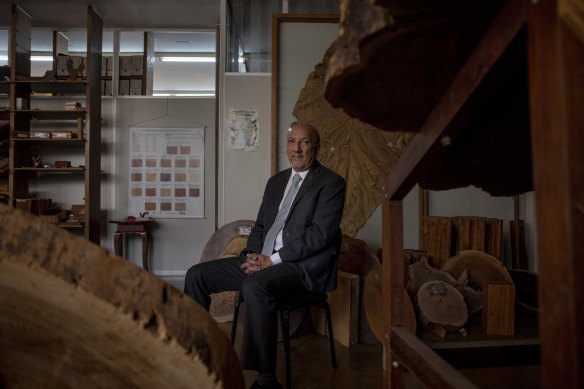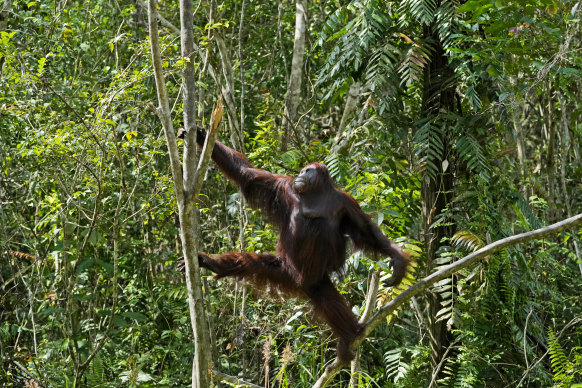This was published 9 months ago
A ‘crazy’ new scheme to save world’s forests
By Manuela Andreoni
What if financial markets treated trees like shareholders? Enter the Tropical Forests Forever Facility, a new fund that Brazil, which is home to about a third of the planet’s tropical forests, is pitching to the world and that would pay developing countries a fee for every hectare of forest they maintain.
The project, first presented at the global climate summit in Dubai last November, is now in its final stages of design, and it could ultimately pay out $4 billion ($5.8 billion) a year to protect forests.

Palm tree plantations at the forest’s edge in Beluran, Malaysia. Brazil is proposing a fund that would pay countries to protect tropical forests from development.Credit: Jes Aznar/NYT
The fund’s mission is to flip the economics that have long fuelled deforestation. Farming, logging and other industries that drive forest destruction can boost local economies, but Brazil’s fund would effectively pay countries for services that tropical forests now perform for free, such as storing planet-warming carbon and regulating rain patterns.
With that, the TFFF, as it’s awkwardly called, aims to stop what has long been considered unstoppable. Countries have been losing about 9 million acres of tropical forest a year over the past two decades. These forests are crucial for storing planet-warming carbon and curbing biodiversity loss.
But promising ideas, like carbon credits tied to curbing tree loss and grant schemes that reward forest protection, have struggled to significantly reverse the deforestation trend globally. Payments from the TFFF may be large and predictable enough to succeed where other initiatives haven’t.
Brazil’s proposal envisions a $US125 billion fund, which would make it, by some measures, the world’s biggest pot of money to help fight climate change and biodiversity loss. The Green Climate Fund, the world’s largest climate fund financing projects in the developing world, has about half of the proposed capital.
“We’re at this stage where everybody’s saying, look, in principle, this is crazy,” said Christopher Egerton-Warburton, who leads Lion’s Head Global Partners, an investment banking firm that focuses on sustainable development and has helped design the proposed fund. “But it’s crazy in a kind of interesting way.”
That’s because, unlike the Green Climate Fund, the TFFF would require no donations. “What we are asking for is an investment,” said Garo Batmanian, the head of Brazil’s forest service and one of the architects of the TFFF.
Here is how it would work: Rich nations and big philanthropies would loan the fund $US25 billion, to be repaid with interest. Getting that capital is the hardest part, the fund’s backers say. That money would then help attract another $US100 billion from private investors. Those investors would be paid a fixed rate of return, just as if they had invested in something with slightly higher projected returns than Treasury bonds.
The TFFF would then reinvest the $US125 billion in a diversified portfolio that could generate enough returns to repay investors. The excess returns would be used to pay roughly 70 developing countries based on how much tropical forest they still have standing.

Garo Batmanian, the director of the Brazilian Forest Service, is one of the architects of the Tropical Forests Forever Facility.Credit: Victor Moriyama/NYT
The design allows the TFFF to essentially create its own grants for forest protection. While that design is unique, the financial mechanism behind it – getting deposits and reinvesting them for a profit – is common. It’s basically how banks work.
“The idea is elegant,” said Frances Seymour, a senior adviser on forests for the US State Department. “It’s exciting that it seems to have some political momentum.”
Brazil aims to finalise the fund’s design by the end of the year, including how it would be governed, and roll it out next year. Brazilian officials are trying to capitalise on the country’s role as host of the UN climate summit in 2025 and its turn this year at the presidency of the Group of 20, to beef up support for the TFFF.
The idea has caught the attention of leaders in United States, Norway, and France, as well as the World Bank, which is helping to develop the project. In a meeting about the TFFF in Rio de Janeiro in July, the bank’s president, Ajay Banga, said that his team had “been encouraged by the work that has gone into this idea.”

Forests are crucial for curbing biodiversity loss. Orangutans are one species endangered by deforestation.Credit: AP
But, at this early stage in the process, no countries or philanthropies have yet announced that they will put money in the fund.
The proposal’s ambition has stirred some scepticism about its viability. Getting rich nations to commit $US25 billion in loans and investments may be easier than getting that sum in traditional grants. Still, it could be enormously challenging. In the United States, for example, it would require approval by a Congress that is divided.
The fund’s goal is to pay countries with low deforestation rates $US4 for each hectare of standing forest that can be identified by satellite images every year. Those forests can be old-growth or restored, not plantations.
The fund’s proponents say it is priced at the absolute minimum to help countries stop deforestation from mining in Indonesia, the growth of cocoa crops in Ghana, the expanding ranches in Colombia and myriad other moneymaking drivers of environmental destruction.
Countries that receive TFFF funds would also be penalised $US400 for each hectare of forest they lost in a given year. The penalty is roughly the same annual revenue that a hectare of land used in a soybean farm in the Amazon would bring in, which is one of the most profitable uses of deforested land in developing countries.
If a country’s deforestation rate becomes too high, the TFFF payments would stop. There’s also the risk of exposing forest protection funds to the swings of financial markets, which could disrupt the fund’s payments to countries.
Still, experts say the impact of a reliable stream of forest protection funds that countries can plan their yearly budgets around could be enormous.
Take Brazil, one of the wealthiest of the forest countries in the developing world. If the fund was already operating, the country would have received some $600 million this year from its existing forests, minus what it lost. That’s almost double the yearly budget of the country’s Environment Ministry.
“We have long talked about the advantages of conservation, but haven’t been able to, let’s say, translate that into concrete things people can feel,” said Marina Silva, Brazil’s environment minister.
But with the fund disbursing real cash for standing trees, she said, politicians who now fight environmental protection policies at every turn may start “counting each hectare of preserved forest and thanking each Indigenous person inside their state”.
How the money gets spent may become a source of tension as the fund’s design is finalised. On the one hand, Seymour said, recipients need some freedom to spend the money without burdensome controls and reporting requirements.
On the other hand, the fund needs to ensure it is actually helping forests and reaching the communities that protect them. “Reasonable people can disagree on what the right balance is,” she said.
Get to the heart of what’s happening with climate change and the environment. Sign up for our fortnightly Environment newsletter.
This article originally appeared in The New York Times.